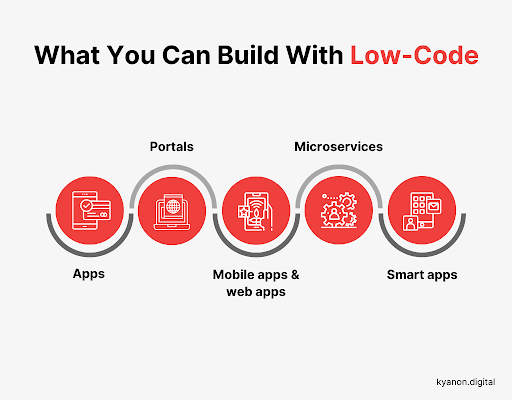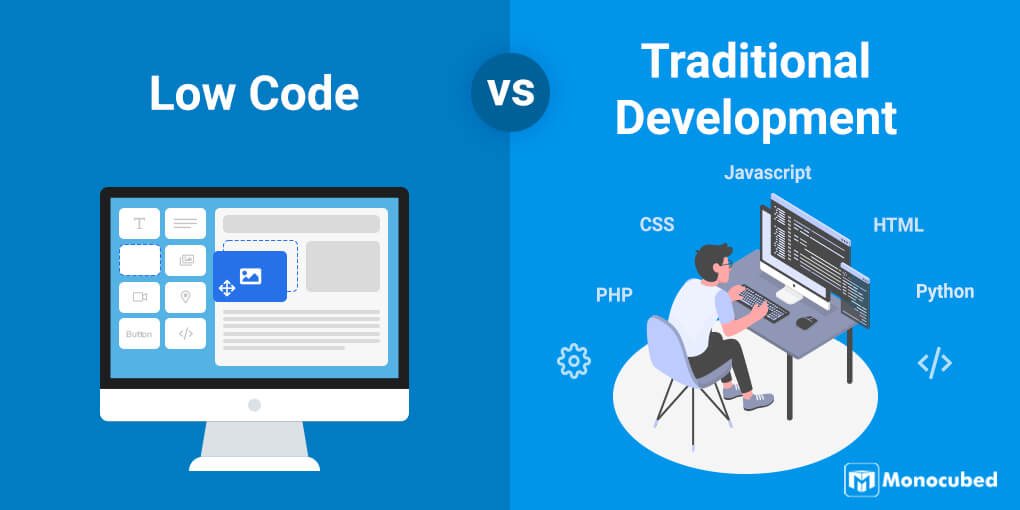Free Info For Choosing Low-Code Platform Recommendations
Free Info For Choosing Low-Code Platform Recommendations
Blog Article
Benefits Of Developing Applications Using Low-Code In Terms Of Speed
Visual Development Environment :
Drag-and-Drop Interfaces: Low-code platforms provide visual tools for designing applications. Drag-anddrop components enable developers to build apps quickly without having to write code.
Templates and pre-built components: Many low code platforms come with pre-built components as well as templates, which allows developers to quickly prototype and build applications.
Coding requirements that are less invasive:
Automated Code Generation: The low-code platform automatically generates the code underneath based upon the visual models that developers design. This eliminates the need for manual coding.
Reusable Parts: Developers will have the ability to reuse reusable parts across different projects, and cut down on the time required for writing and testing of code.
A more efficient collaboration
Low-code platform tools typically contain versions control, testing or deployment. This facilitates the seamless communication between teams.
Citizen development: By using simple interfaces and decreasing bottlenecks that are often caused by limited availability of developers, business users and non-developers are able to assist in application development.
Rapid Iteration and Prototyping:
Rapid prototyping: Designers can create quickly prototypes to collect feedback and confirm ideas, which results in quicker cycles of iteration.
Simple Modifications - The visually appealing nature of low-code development permits for easier changes and updates which speed the refinement of applications based upon user feedback.
Pre-built Integrations:
API Integrations: Low-code platforms usually come pre-built with connectors for popular services and APIs. This can reduce the time required to integrate other systems.
Data Integration: The integrated tools simplify the process of connecting to databases and other sources, accelerating the process of development.
Deployment and Scaling:
One-Click Deployment: Many low-code platforms provide the option of deploying with one click, drastically decreasing the amount of amount of time and effort required to deploy apps.
Cloud-based solutions: Cloud platforms with low-code let developers focus on the functionality and logic of their applications, rather than worrying about logistics for deployment.
The main advantage of low-code application development in terms of speed, is the ability to automate and simplify many aspects of the process. This allows for quicker delivery of applications and quicker adaptations to changing requirements. Check out the most popular from this source on Low-code Platform for application development for more examples including rad application development, application modernization, mobile app development platforms, low code platforms, application modernization software, azure sql databases, driver jdbc, build with docker, cloud software applications, application modernization software and more.
Benefits Low-Code Applications In Governance And Safety
Low-code development can bring many advantages regarding security and governance. They are essential to ensure that apps are secure, compliant and well-managed through their entire lifecycle. Here are a few of the main advantages.
Unified management console: Low-code platforms usually provide a central administration console where administrators can manage all applications and ensure consistent governance within the company.
Role-Based Access Control (RBAC) The majority of these platforms offer an extensive role-based access control system that allows administrators to establish and enforce access policy. Only authorized users are permitted to modify and access certain areas of the application.
Conformity and Regulatory Conformity:
Built-in Compliance Features: A lot of low-code platforms are built to be compliant with industry standards as well as regulations (e.g., GDPR, HIPAA). They offer templates and tools to ensure that the applications are compliant with these standards.
Audit Trails and Logging: Complete audit trails and logs can be integrated to allow organizations to track change in access, and monitor access and conformity.
Increased Security Measures
Data Encryption : Low-code platforms often offer built-in data encryption in transit and at rest. This ensures that sensitive data is secured.
Security Certificates: Many low-code companies have a security certificate (e.g. ISO 27001 and SOC 2) which demonstrate that they are adhering to strict security standards. They offer an additional security level to their customers.
Automated updates for security:
Regular updates and patching Low-code platforms manage the majority of security patches and updates in a way. They ensure that applications are secure from the latest attacks without requiring developers to intervene manually.
Security Monitoring Tools: Tools for constant security monitoring are available. They send real-time alerts, as well as insights into possible security issues.
Data Governance
Data Access Policy: These systems let organisations define and enforce policies regarding data access, ensuring certain that only authorized users are able to access data, and they are using it in a proper manner.
Data Masking and Anonymousization The tools built into the system to hide and anonymize data helps protect sensitive information in development and testing environments.
Consistent Application Lifecycle Management:
Pipelines for Development and Deployment Low-code platforms typically offer integrated pipelines for development and deployment that include security checks, which ensure security is maintained throughout the application lifecycle.
Version Control: A unified version control system can help control changes, allowing any modifications that are made to an application to be tracked. If needed the changes can be reversed and the integrity of the application maintained.
User Authentication:
Single Sign-On Support for single sign-on (SSO), and other advanced methods of authentication, simplifies management and increases security.
Multi-Factor Authentication (MFA) A number of platforms provide built-in support to multi-factor authentication. It adds an extra layer of security when accessing applications.
Monitoring of Policy Enforcement and Compliance:
Policy Templates: Low code platforms often include pre-defined templates for governance and security that allow organizations to quickly apply policies.
Compliance Monitoring Tools: These give continuous monitoring and a report on compliance status. This makes it easier to identify potential issues and take action to address them.
Integrating with Existing Security Infrastructure
Integration seamless: Low-code platforms are able to be seamlessly integrated with the existing security tools and devices like firewalls and SIEM solutions (Security Information and Event Management), and identity management systems.
API Security: API integrated security makes sure that integrations with an external system are secured. Keep data safe and ensure the application's consistency.
Best Practices and Training:
Many platforms offer guides and best practices for secure application development. They can help developers who are not developers to adhere to security standards.
Some low-code vendors offer security education to help users develop and maintain secure applications.
Low-code development offers a number of governance and security benefits that ensure applications are developed and managed in a efficient, secure and compliant manner. These platforms offer the frameworks and tools necessary to protect sensitive information, enforce policies and maintain regulatory compliance, while facilitating managing and monitoring. Check out the top Enterprise application development with Low-code Platform blog for more info including cross platform app development, rad application development, azure sql databases, stored sql procedures, push notifications, low code platforms, azure sql, sso azure, rapid application design, application modernisation and more.
Advantages Of Developing Applications Using Low-Code In Terms Of Limitations And Customization
Low-code application development is a balancing solution that provides significant benefits in addressing limitations while providing the ability to customize. These are the advantages:
In overcoming Complexity Barriers:
Simple Development: Low-code platforms cut down on the complexity of development by providing templates and components pre-built for you that allow for faster development and deployment even for complicated applications.
Many platforms have guided workflows, which help developers navigate through complicated procedures. They decrease the chances of errors and ensure uniformity.
Scalability Solutions
Scalability integrated into Low-Code platforms: Low-code platforms usually come with features that enable scaling architecture. This allows applications to handle greater loads without massive re-development.
Performance Monitoring Performance Monitoring: Tools for monitoring performance and optimization ensure the applications run as efficiently as they can be, regardless of their size.
Security and compliance:
Low-code platforms come with security features such as security access control that is based on roles as well as encryption and automated checks for security compliance. These security features address most common security concerns.
Platforms frequently update their compliance and security measures to ensure that applications are protected against new threats.
Options for Customization:
Extensibility:
Low-code Platforms Allow Custom Code Platforms that allow the integration and usage of customized code.
Developers can design custom plugins and modules with functions that can be specifically tailored to meet the needs of specific businesses.
APIs and Integration
API Support: Full API support is available to enable seamless integration and connection with other systems.
Third-Party Service: Low-code platforms provide built-in connectors for popular third-party service providers, making it easier to add and modify apps.
Flexible Design for UI/UX:
Customizable user interfaces: Developers are able to modify and design the user interfaces to fulfill specific branding requirements as well as requirements for usability, resulting in the user with a customized experience.
Responsive Design: Built-in responsive design capabilities mean that apps can be customized for various screens and devices.
Business Logic Customization
Visual Workflow Builders: Visual tools to build and modify workflows. business logic and processes enable developers to develop complex and tailored processes without the need for programming.
Platforms provide conditional logic that can accommodate certain business rules or situations.
Data Management:
Custom Data Models: Developers have the option to create customized data models specifically for particular applications, and tailoring the handling of data to specific business requirements.
Advanced Data Processing: Integration of advanced tools and capabilities for data processing allows for customizing how data is analyzed and used within the application.
Balanced Limitations and Customization
Frameworks, Standards and Standards:
Best Practices: Low-code platform encourages compliance with standards and industry best practices. This can be helpful to ensure high-quality secure, scalable, and scalable applications.
Governance Frameworks - Built-in governance systems ensure that customisations do not affect security, integrity, or compliance.
Iterative Development and Feedback
Rapid Prototyping : Developers can quickly test and prototype customizations using the feedback of users, enhancing the application according to their requirements.
Low-code platforms enable continuous improvement by allowing continuous customization and further enhancing as requirements for business change.
User Empowerment
Giving Citizen Developers the tools they need: By enabling non-developers to create customisations using easy interfaces, low-code platforms expand the number of users who can improve and customize applications.
Support and Training Resources: Many platforms provide extensive training and support materials to help users customize applications without compromising functionality or stability.
Overall, low code application development provides a robust framework that can address the weaknesses and provides a wide range of options for customization. This balance ensures businesses can develop and maintain applications that are tailored and functional to meet their particular requirements, while maintaining the highest standards of quality, safety and the ability to scale.